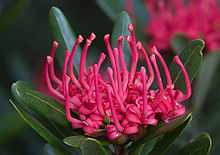Telopea truncata
| Telopea truncata | |
|---|---|
 | |
| Scientific classification | |
| Kingdom: | Plantae |
| (unranked): | Angiosperms |
| (unranked): | Eudicots |
| Order: | Proteales |
| Family: | Proteaceae |
| Genus: | Telopea |
| Species: | T. truncata |
| Binomial name | |
| Telopea truncata (Labill.) R.Br. | |
Telopea truncata, commonly known as the Tasmanian waratah, is a plant in the Proteaceae family endemic to Tasmania in Australia. It grows as a multistemmed shrub or small tree, with red flower heads, known as inflorescences, appearing over the Tasmanian summer (November to February). Yellow-flowered plants are occasionally seen.
Taxonomy and evolution
French botanist Jacques Labillardière described the Tasmanian waratah as Embothrium truncatum in 1805. Embothrium had been a wastebasket taxon at the time, and Robert Brown suggested the genus Telopea for it in 1809, which was published in 1810.[1] Richard Salisbury had published the name Hylogyne australis in 1809, but Brown's name was nomenclaturally conserved. The species name is the Latin adejctive truncatus "truncated' or "ending abruptly" referring to the end of the seed wing.[2]
Telopea truncata is one of five species from southeastern Australia which make up the genus Telopea.[3] The genus is classified in the subtribe Embothriinae of the Proteaceae, along with the tree waratahs (Alloxylon) from eastern Australia and New Caledonia, and Oreocallis and the Chilean firetree (Embothrium coccineum) from South America.[4][5] Almost all these species have red terminal flowers, and hence the subtribe's origin and floral appearance must predate the splitting of Gondwana into Australia, Antarctica, and South America over 60 million years ago.[6] Triporopollenites ambiguus is an ancient member of the proteaceae known only from pollen deposits, originally described from Eocene deposits in Victoria. The fossil pollen closely resembles that of T. truncata,[7] Alloxylon pinnatum and Oreocallis grandiflora.[8] Fossil remains of Telopea truncata have been recovered from early to middle Pleistocene strata at Regatta Point in western Tasmania. These beds housed a subalpine plant community in what is now lowland terrain.[9] Leaves identical to (and classified as) Telopea truncata have been recovered from early Oligocene deposits around Lake_Cethana near Sheffield.[10]
Description
The Tasmanian Waratah is a large erect shrub up to 3 metres (10 ft) in height with several stems, although sometimes grows as a single-stemmed tree to 8 m (25 ft) high. Flowering occurs from November to February. The flower heads, known as inflorescences, are 3.5 to 6 cm (1.6–2.4 in) in diameter and composed of 10 to 35 individual flowers. They are most commonly bright red, though sporadic yellow-flowered plants occur. These were described as forma lutea but have no taxonomic status, as they appear sporadically and are mere colour variations.[3]
Distribution and habitat

The species is found in central, southern and western Tasmania. It grows on moist acidic soils in wet sclerophyll forest or subalpine scrub at altitudes of 600 to 1200 metres.[11]
Cultivation
The Tasmanian waratah can be propagated by seed, though this is vulnerable to damping off.[11] It grows best in a cool climate with ample water and good drainage, and has done well in cultivation in England. The Royal Horticultural Society gave it an Award of Merit in 1934 and First Class Certificate in 1938.[2]
Cultivars
- Telopea 'Champagne' is a cultivar registered under Plant Breeders Rights (PBR) in 2006.[12] Its creamy-yellow flowerheads appear from October to December.[13] It is a three-way hybrid between T. speciosissima, T. oreades and the yellow-flowered form of T. truncata.
- Telopea 'Golden Globe' is a cultivar registered under PBR in 2006.[14] Larger than 'Champagne', it is also a three-way hybrid between T. speciosissima, T. oreades and the yellow-flowered form of T. truncata. It has been propagated and sold as 'Shady Lady Yellow'. It was originally bred in the Dandenongs east of Melbourne.[13]
References
- ↑ "Telopea speciosissima". Australian Plant Name Index (APNI), IBIS database. Centre for Plant Biodiversity Research, Australian Government, Canberra. Retrieved 31 March 2012.
- ↑ 2.0 2.1 Wrigley, John; Fagg, Murray (1991). Banksias, Waratahs and Grevilleas. Sydney: Angus & Robertson. pp. 538–42. ISBN 0-207-17277-3.
- ↑ 3.0 3.1 Crisp, Michael D.; Weston, Peter H. (1995). "Telopea". In McCarthy, Patrick (ed.). Flora of Australia: Volume 16: Eleagnaceae, Proteaceae 1. CSIRO Publishing / Australian Biological Resources Study. pp. 386–390. ISBN 0-643-05693-9.
- ↑ Johnson, L. A. S.; Briggs, Barbara G. (1975). "On the Proteaceae: the evolution and classification of a southern family". Botanical Journal of the Linnean Society 70 (2): 83–182. doi:10.1111/j.1095-8339.1975.tb01644.x.
- ↑ Weston, Peter H.; Barker, Nigel P. (2006). "A new suprageneric classification of the Proteaceae, with an annotated checklist of genera". Telopea 11 (3): 314–44.
- ↑ Nixon, Paul (1997) [1989]. The Waratah (2nd ed.). East Roseville, NSW: Kangaroo Press. p. 19. ISBN 0-86417-878-6.
- ↑ Dettmann, Mary E.; Jarzen, David M. (1991). "Pollen evidence for Late Cretaceous differentiation of Proteaceae in southern polar forests". Canadian Journal of Botany 69 (4): 901–06. doi:10.1139/b91-116.
- ↑ Martin, A. R. H. (1995). "Palaeogene proteaceous pollen and phylogeny". Alcheringa: an Australasian Journal of Palaeontology 19: 27–40. doi:10.1080/03115519508619096.
- ↑ Jordan, G. J.; MacPhail, M. K.; Barnes, R.; Hill, R. S. (1995). "An Early to Middle Pleistocene Flora of Subalpine Affinities in Lowland Western Tasmania". Australian Journal of Botany 43 (2): 231–42. doi:10.1071/BT9950231.
- ↑ Carpenter, Raymond J.; Jordan, Greg J. (1997). "Early Tertiary Macrofossils of Proteaceae from Tasmania". Australian Systematic Botany 10 (4): 533–63. doi:10.1071/SB96016.
- ↑ 11.0 11.1 "Telopea truncata". Australian Native Plants Society. Retrieved 15 November 2009.
- ↑ "Waratah (Telopea hybrid): Variety: 'Champagne'". IP Australia: Plant Breeders Rights website. IP Australia, Commonwealth of Australia. 2006. Retrieved 18 December 2011.
- ↑ 13.0 13.1 Elliot, Rodger W.; Jones, David L.; Blake, Trevor (2010). Encyclopaedia of Australian Plants Suitable for Cultivation: Volume 9 – Sp-Z. Port Melbourne: Lothian Press. pp. 200–03. ISBN 978-0-7344-0974-4.
- ↑ "Waratah (Telopea hybrid): Variety: 'Golden Globe'". IP Australia: Plant Breeders Rights website. IP Australia, Commonwealth of Australia. 2006. Retrieved 18 December 2011.
| Wikimedia Commons has media related to Telopea truncata. |